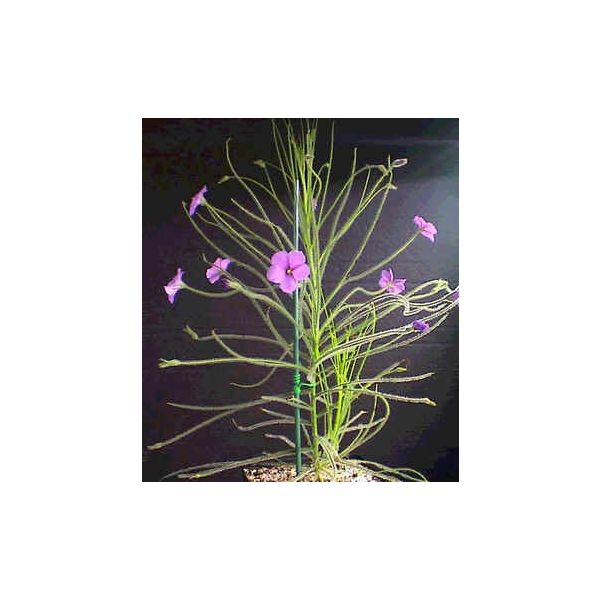Byblis Lamellata Seeds (Rainbow Plant Seeds)
Byblis Lamellata Seeds (Rainbow Plant Seeds)
Glittering and often delicate, Byblis, the Rainbow Plants, can sometime appear as frosted sprays of water, and in sunlight can sparkle with multicolored hues.

Delivery
All orders shipped with UPS Express.
Always free shipping for orders over US $250.
All orders are shipped with a UPS tracking number.
Returns
Items returned within 14 days of their original shipment date in same as new condition will be eligible for a full refund or store credit.
Refunds will be charged back to the original form of payment used for purchase.
Customer is responsible for shipping charges when making returns and shipping/handling fees of original purchase is non-refundable.
All sale items are final purchases.
Help
Give us a shout if you have any other questions and/or concerns.
Email: contact@domain.com
Phone: +1 (23) 456 789
Availability: Out of stock
SKU
Byblis Lamellata
Byblis lamellata is found near Arrowsmith river in Western Australia. It is closely related to Byblis gigantea. Recent DNA testing indicates that the Byblis' closest relatives are Butterworts, Pinguicula. The structure of the flower does resemble that of the of the Bladderworts and Butterworts. Byblis lamellata grows naturally as an annual, but can be kept as a biennial if grown in constantly moist soils. It grows easily up to 30-50 cm.
Glittering and often delicate, Byblis, the Rainbow Plants, can sometime appear as frosted sprays of water, and in sunlight can sparkle with multicolored hues. Since the plants grow as annuals, they must flower the same year that they germinate in order to produce sufficient seeds for the next year. The first flowers appear when the plant is just a few months old. Byblis lamellata does self-pollinate. Flowers are from pink, to dark pink, to purple, even white, depending of the colony. Occasionally, the plants survive the Winter and continue growing in Spring.
After Byblis lamellata matures, it should not be repotted because it has a sensitive root system, which won't regrow if damaged. Only the young plantlets, 1-2 cm may be transplanted, very carefully before their roots establish themselves securely in the planting medium. When transplanting, remove a ball of soil with the roots.
Insects are attracted to the dew of the Byblis The nectar is secreted by hundreds of glands that sit on top of the long tentacles of the fine, linear leaf. These leaves branch out from the main stem in all directions. When the insect lands on the plant, it becomes glued tight by this sticky substance. Eventually the insect dies from exhaustion and suffocation. The leaves of the Byblis do not have the gift of movement so they do not curl around their prey as some Drosera are known to do. When the insects succumb and cease to struggle, a second gland, that lie flat along the leaf, come into play. These sessile glands begin to secret a digestive juice that dissolves the soft parts of the insect.
Hardiness zone 11, (4øC/40øF) in Winter. The Byblis experiences dry Summer dormancy, but this is not necessary in cultivation. Best grown under indirect or artifical light. The Rainbow plant does best in tropical climates, but its annual nature allows you to grow it during any span of several months of warm weather.
This is certainly one of the easiest plant to grow because its seeds germinate and grow in any medium without any special treatment. Use a 50/50 sand/peat moss mix or two parts sand for one part peat moss, in a deep pot because the plants live longer, in smaller pots they tend to be annuals. In big pots they also branch more to make a bushy plant, especially if just a few plants are grown in a pot. Keep the soil damp but not permanently waterlogged. You can use the tray method for watering, allow all the water to evaporate from the tray before replenishing. Water with rain water or distilled water, city hard water will kill your carnivorous plant. Do not fertilize.
| Common name | Rainbow Plant |
|---|---|
| Species | Byblis lamellata |
| Germination | Sow the seeds directly on the surface of your moist but not soaked soil mix. Cover the top of the pot with clear plastic so the humidity will remain high, place them in an area with real nice strong light and keep the temperature around 15-25øC. When you see some tiny plants starting to sprout, slowly open the top of the pot, a little each day, so that the new seedlings don't go into shock from the humidity being lowered too quickly. Make sure to be gentle at all time with the new seedling, not to destroy anything. Germination usually occurs in days or 2-6 weeks. Make sure that it gets good air circulation. |
| Price View | Price Range |

